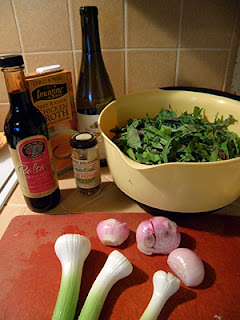 |
| US White Shrimp: Large and Reasonably Sustainable |
Recipe Adapted from Recipes from the Root Cellar
I love shrimp and have noticed that readers do too. However,
in years past it’s not been easy to find sustainably produced shrimp. Old
school fisheries involve dragging a net along the bottom of the ocean, with a
huge amount of bycatch:
about 4 lbs. for every 1 lb. of shrimp caught. Many shrimp farms are open to
the ocean, leaching antibiotics, commercial fish food, and shrimp waste into
the environment. Some shrimp farmers destroy native mangrove ecosystems to
build farms. Luckily, the Monterey Bay Aquarium publishes sustainable shrimp guidelines, and they are getting easier to follow. Trending now are
hook-and-line caught shrimp and closed-system farms. The rebuilding of the US
Gulf of Mexico fisheries after Hurricane Katrina and the pioneering of closed-system farming enterprises in Thailand and Vietnam are both great news
for shrimp eaters. And if I’m reading the guidelines
right, we can now buy sustainable shrimp at Costco for under $10 per pound.
 |
| Shrimp and Kale: Colorful, Healthy & Yummy |
 |
| Cutting Kale into Strips |
 |
| With Shallots & Green Garlic |
serves about 6
2 medium shallots
2 – 4 stalks green garlic
2 tbsp. olive oil
1 large bunch of Red Russian kale
½ tsp. crushed red pepper flakes
1½ - 2 lbs. shrimp, peeled and deveined
¾ cup chicken or veggie broth
¼ cup dry white wine
~ ¼ tsp. salt
A few grinds of black pepper
1 – 3 tbsp. high quality balsamic vinegar
Cooked Rice, to serve over, or crusty bread (optional)
Mince shallots and green garlic. You should have about ¾ cup
of each.
Wash kale and remove thick stems. Stack up leaves and cut
into ½ inch or smaller strips. Douse with water and drain. You should have
about 10 cups.
Peel and devein/clean shrimp. Pat dry with towel.
Peel and devein/clean shrimp. Pat dry with towel.
Heat oil in electric frying pan at 325 degrees (medium
high). Add shallots, garlic, and red pepper flakes. Sauté until fragrant,
stirring constantly, about 2 minutes.
Add damp kale a handful or two at a time. Stir and sauté
each handful until it begins to wilt, then add the next handful (unless you can
fit all the kale into the frying pan at once). After about 4 minutes, all kale
will be semi-wilted. Reduce heat to 275 degrees (medium), cover and steam until
kale starts to get tender, about 5 minutes.
Turn heat up to 325 degrees again. Add shrimp and sauté
about 2 minutes, stirring constantly to partially cook the shrimp.
When all shrimp are partially opaque, stir in broth and
wine. Cover and cook for another 2 minutes, then open lid and stir so that
shrimp will cook evenly. Cover and cook until shrimp are just opaque, another 1
– 3 minutes depending upon size of shrimp.
Season with salt and pepper. Drizzle with 1 – 2 tbsp.
vinegar, depending upon how much shrimp you used.


Shrimp is such a versatile product. You can have it by itself and it tastes good. It does not matter whether it is cooked, or uncooked in sushi, once it is fresh. The freshness, as with all seafood, helps to determine the flavor.
ReplyDeleteI think combining this type of seafood with green vegetables is a good idea. It gives you the best of two worlds, when it comes to vitamins and other nutrients. Kale is a nice seasonal vegetable and people are always looking for new ways to cook it.
Indeed, freshness is the key to all seafood. Find some good sources, and stick with them! :)
Delete